10 Cheap Coupes with 300+ hp
We love breaking down data in different ways here at Insider. Recently, we decided to look at value through a different lens: cost per horsepower. A healthy discussion ensued, with many of you sharing that you’d gladly pay a little extra for a trimmer body style, a high-performance package, or a V-8.
To our lengthy spreadsheets we returned, playing with the filters to yield a fresh list. This time, we set the threshold at 300 hp and looked only at two-door models. To keep the selection affordable, we restricted ourselves to cars that cost no more than $15,000. We didn’t want to just be talking about rough examples, either, so all values you see here are for vehicles in #3 condition—well-maintained, driver-quality cars, in other words.
The choices vary wildly across the decades. First off, no car in the Hagerty Price Guide from the ’80s meets these criteria. Sports cars with 300 horsepower existed in the ’80s, of course, but none are cheap, as defined here. The same is true for the 2010s: Powerful two-doors abound (hello, C7 Stingray), but they’re well into the $30,000 range. We had to head back to 2010 and Ford’s Mustang (315 hp, $13,600) to meet each of our thresholds. A smattering of foreign cars from the ’90s and ’00s fit our filters, but none show up in any prior decade. Together with how expensive ’80s cars have become, this won’t surprise any good student of automotive history.
In general, you’ll find the richest selection of two-door classics with 300 or more hp in the 1960s or in the 1990s through the 2000s. To make sure no decade is under-represented, we’ve chosen two from each decade—excluding the ’80s, for the reasons listed above.
Without further ado, here are 10 affordable two-doors, most of them with V-8s, and all with 300 or more hp.
2005 Ford Mustang GT
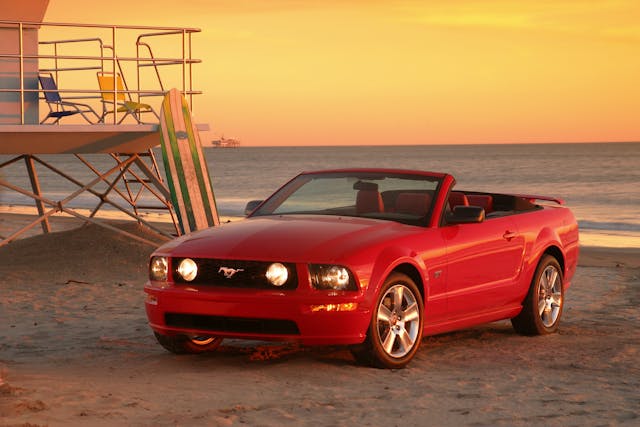
Horsepower: 300
#3 value: $14,800 (convertible)
Mustangs from the S197 generation, especially those that predate the 2010 facelift, are some of the most accessible ways into 300+ horsepower. Even better, both the coupe and convertible variants of the GT model (the entry-level V-8) can be found for under $15K: Droptops are just a skosh under that figure, but the coupes from 2005–09 are only $12,600 in #3 condition. The V-8 got you a host of upgrades from the base V-6 car, plus the glorious exhaust note that’s worth the price of admission in and of itself.
2008 Nissan 350Z Roadster

Horsepower: 306
#3 value: $11,600 (Base)
Bucking the usual trend of coupe versus convertibles, the soft-top version of Nissan’s 350Z is the one that’s more affordable. Horsepower varies across the model years, and even among the trim levels until 2007, when Nissan decided to put the same 306-hp variant of its VQ-series V-6 in all of the cars. Redline increased by 500 rpm, to 7500, and fuel economy ticked up, as well. The only downside is the additional cost of the performance goodies: If you want the limited-slip diff, stability control, or cruise control, set aside another two grand and look for the Enthusiast trim. But if you want simple, top-down sporting fun? The base 350Z is your champ.
1999 Chevrolet Camaro Z/28 Coupe
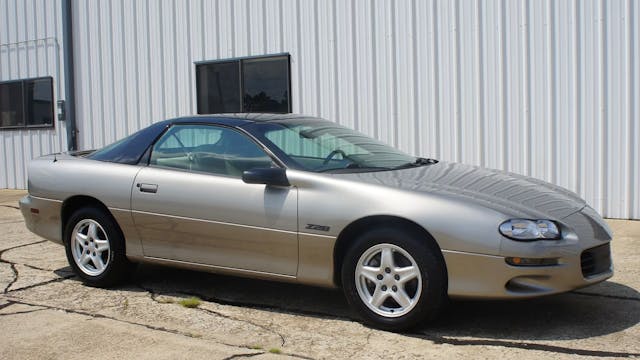
Horsepower: 305
#3 condition value: $12,400
The fourth-gen Camaro follows the general rule that when the top goes down, the price goes up. If you’re on a budget, you can work this to your advantage: a 1999 Z/28 coupe with a manual transmission and the 5.7-liter, 305-hp LS1 goes for $12,400, while the droptop is $20K. (Those who know these cars agree that 305 hp is quite conservative.) This model year also marked the arrival of a Torsen diff for the Z/28 model. Though it ultimately went away after 2002 because of a new head-impact crash standard, the F-body Camaro Z/28 is a stylish, modern, and affordable avenue into the legendary nameplate.
1998 Mercedes-Benz SL500 Roadster
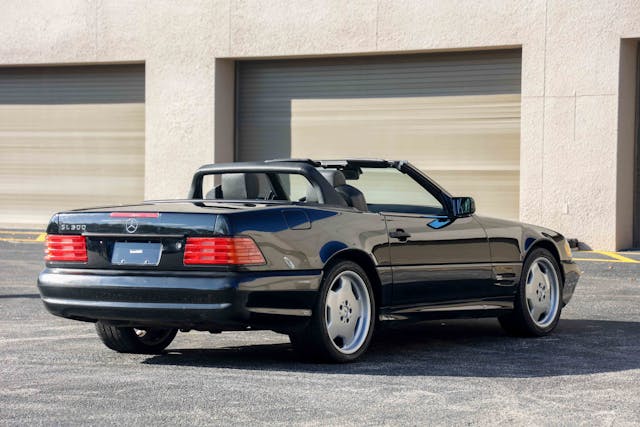
Horsepower: 315
#3 price: $14,800
It’s hard to imagine a stronger contrast between the two foreign-make cars on this list, though both are roadsters. As we noted in our buyer’s guide for this generation (R129) of SL, this luxurious, over-engineered German roadster hails from the cost-is-no-option era of Mercedes-Benz product development. Both elaborate and stout, this 315-hp, V-8-powered droptop is a ton of car for $14,800. This model year is a bit of a sweet spot: Just two years prior, that M119 engine received individual ignition coils, lighter pistons, and a five- rather than a four-speed automatic. A year later in 1999, Mercedes swapped the M119 for the M113, a single- rather than dual-overhead cam V-8 that made 13 fewer horsepower.
1970 Mercury Marauder
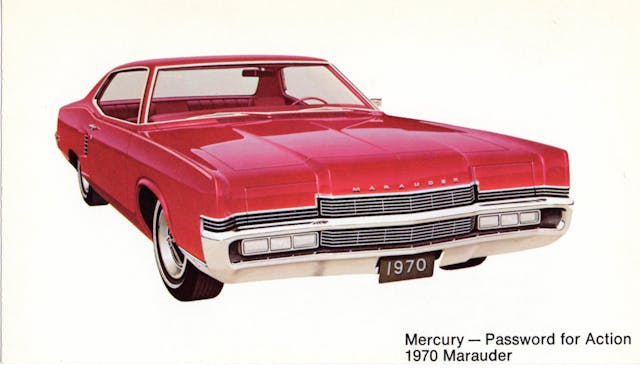
Horsepower: 360
#3 condition value: $13,600
Unlike many of the cars on this list, the ’71 Marauder doesn’t require you to give up its highest-spec engine to stay under fifteen grand. Marauders equipped with the 429-cubic-inch, 360-hp Cobra Jet cost just $13,600 today, and even those with the X-100 package are just $15,200. (Ticking that box added a host of options: automatic transmission, rear fender skirts, two-tone paint, leather upholstery, and alloy wheels.) Dripping with power and luxury, this personal luxury coupe nonetheless didn’t sell that well, but that just means if you show up at a car show with one today, there probably won’t be anything else like it.
1971 Pontiac Grand Prix
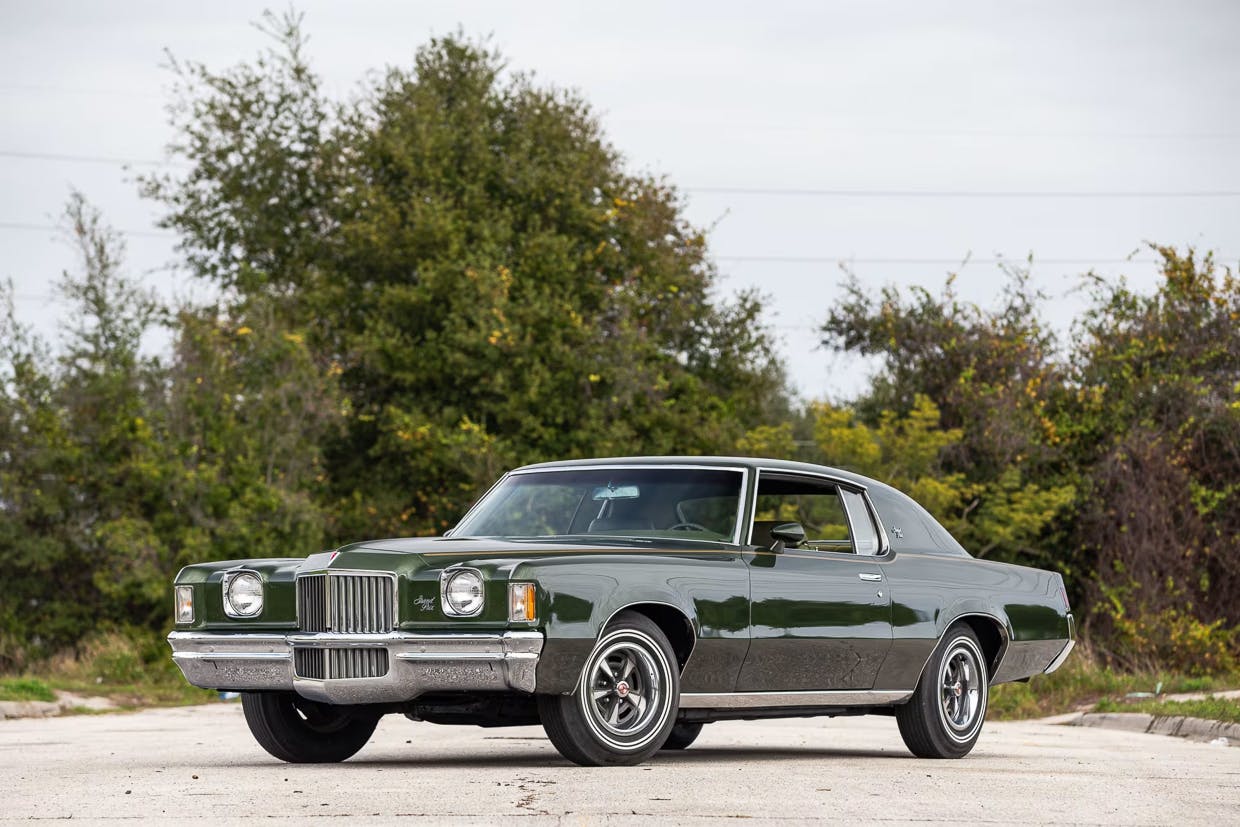
Horsepower: 300
#3 condition value: $14,300
If you dig the ’71 Grand Prix, you don’t just like beak—you like boattail, too. Though not as dramatic as Buick’s Riviera of the same period, Pontiac added the distinctively molded rear deck lid to its personal luxury coupe in ’71. As has been well-told, the ’70s weren’t the best time for big power numbers. Compression began dropping after 1970, the industry method for calculating horsepower changing from gross to net in 1972, and the one-two punch of emissions regulations and fuel crisis impact all conspire to explain why all of the sub-$15K, 300+ horsepower cars from this decade hail from 1970 or 1971.
The best deal for the most powerful Grand Prix is the higher tune of the standard, 400-cubic-inch engine, which squeaks into this list with 300 hp. The 455 was reduced from 370 to 350 hp for ’71, and costs over twice as much today: $32,000 for an example in #3 condition.
1965–69 Avanti II

Horsepower: 300
#3 condition value: $13,000
Looking for something powerful but off-beat? Check out the funky fiberglass Avanti II, designed by Studebaker and powered by a Chevy 327 V-8. Available in a wild array of colors, both inside and out, the Avanti II (1965–69) is surprisingly affordable for such an oddball. Values are essentially flat across the production years: a ’65–67 model carries a value just $200 higher than its ’68–69 brethren. These Avantis, produced after original maker Studebaker closed its factory in ’63, reached production thanks to a pair of car dealers from the brand’s home town of South Bend, Indiana, who bought production rights to the model name and a bunch of spare parts.
You’ll pay another 10 percent on top of the Avanti’s #3 value for factory air conditioning or a four-speed … but since that value is $13,000, you’re still under $15K with one or the other desirable add-on.
1968 Oldsmobile Delta 88 Holiday Coupe
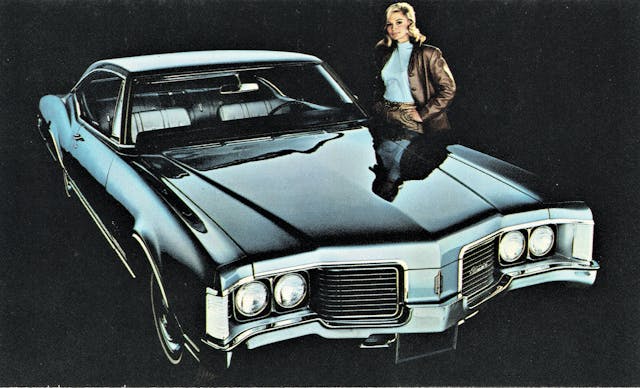
Horsepower: 310
#3 condition value: $11,300
Offered across 50 years, the 88 was the top-selling Oldsmobile in the ’50s and the ’60s. As of the 1967 model year, the 88 received a facelift, adding more beak and more fender flare. The following year ushered in some subtle but elegant changes: the center section of the grille was changed to body color, and the turn signals were no longer squeezed in between each pair of round headlamps. The 1968 model year was the last that “Delta” would denote a trim level on the 88; afterward, it was absorbed into the name of the model.
The 88 may not be as coveted as other names of full-sized ’60s performance—Chevrolet’s Impala SS, Ford’s Galaxie—but the ’68 year in particular is one of the best deals for a handsome, powerful muscle car, especially if you forgo the convertible and its $4000 premium: The 425-cubic-inch V-8 made way for a 455-cubic inch mill, adding 10 horsepower, for a total of 310.
1959 Lincoln Premiere Coupe
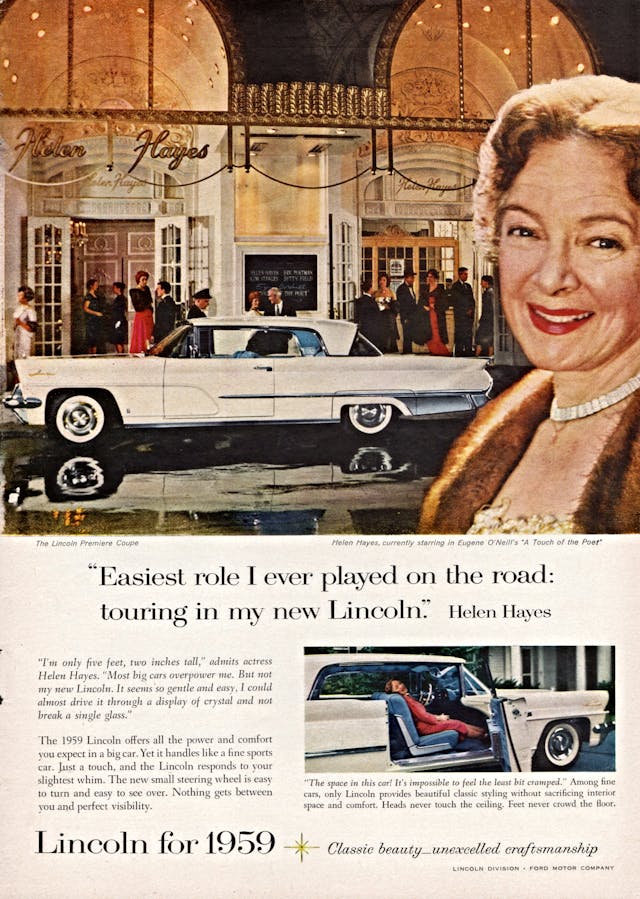
Horsepower: 350
#3 condition value: $13,700
Totally new for 1958, with unibody construction, the Lincoln Premiere immediately established itself as large and in charge—not only in luxurious appointments and overall footprint, but in engine displacement: Both the ’58 and ’59 model years were powered by a 430-cubic-inch V-8, though power dropped from 375 to 350 hp as of 1959. Hardtop sedans were the most popular, and those from ’58 and ’59 both qualify for this list, with #3 values of $13,700 and $12,000, respectively. We’d dare to say that the Thunderbird below, with its separate grille and headlights, looks a bit more modern: But if you want the most luxurious car made by Ford in the ’50s—and if your budget doesn’t stretch to a Continental Mark II—there is no substitute for the Premiere.
1959 Ford Thunderbird Coupe
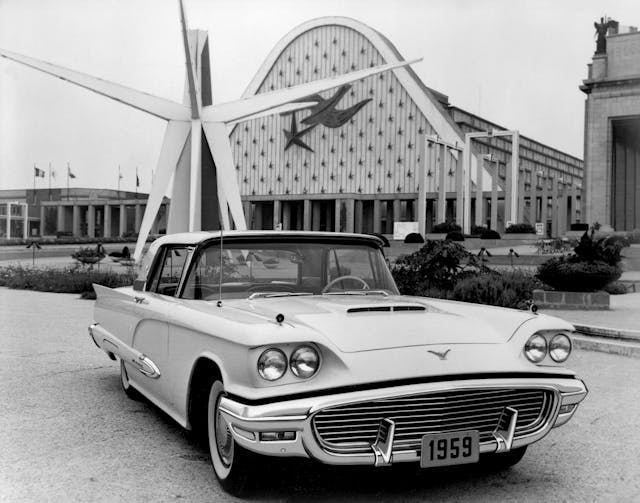
Horsepower: 300
#3 condition value: $13,900
If you’re looking for ’50s glamour and a recognizable model name, the second-gen Thunderbird offers a lot of bang for your buck … especially when you consider that the 1959 coupe is nearly $12K cheaper than the convertible, even when both are equipped with the 352-cu-in engine. Touted in a 1959 brochure as the “newest” version of Ford’s “famous Thunderbird V-8,” this four-barrel powerplant from the FE family was the second-largest engine available for 1959, which saw the introduction of the 430-cu-in MEL V-8. If you’re a big fan of the MEL—we are—consider adding $700 to your budget and buying a ’59 coupe with that engine: You’ll gain an extra 50 hp.
If you’re strict about your $15K budget, however, you may need to do without A/C: The factory-installed option carries a 10 percent premium in our price guide, and even if you go the modern route, and shop the Vintage Air catalog, you’re still looking at $1900 before labor.
***
Want a better understanding of what’s driving collector car values? Sign up for the Hagerty Insider newsletter.



Point I feel obliged to correct. The article indicated a one two punch of emissions regulations and the fuel crisis is responsible for horsepower going away in the 1970s. I find many people in the car business blame the fuel crisis because it hits at the same time as the emissions regulations but that was just a coincidence. The early 1970s emissions regulations were the cause. I would use the 1974 Mustang II as an example it hit the show rooms in the fall of 1973. In October of 1973 the Arab oil embargo hit. The anemic Mustang II was already planned and built before the fuel crisis.
You will get better service, longevity, efficiency and not look foolish driving like a punk from the milder tuned engines.
I agree with many you on HP rating, grab anything from late to early 70s and good to go. Show me a Grand Prix in decent shape for less than 15K, Hagerty is smoking tire rubber smoke! Pick any off the off the wall GM like the Delmont, Buick 225, or Catalina with the 455 – not gonna find them either, not with that engine anyway. What about the Camaro, no FNNNNN way your going to pick one up for less than 15K as well!
COUPE: (noun) a car with a fixed roof, two doors, and a sloping rear.
–Oxford Languages
Let’s compare a 3000 pound Nissan 350Z’s 306 HP to a 6000 pound Delta 88’s 310 HP.
What?
Ummmmm… what they all said (except the guys who refuse to believe that Hagerty price guides are accurate, reflecting either their optimism or their refusal to use today’s technology). This is a lovely walk in the 300+ hp park, but it is a quirky (at least) criterion for a category. More to the point, it leaves out the only factor that an actual driver (as opposed to a numbers nerd or maybe a stoplight racer) cares about: hp-to-weight ratio. Lotus, anyone? My nimble 6-speed manual 205-hp coupe that weighs 3000 lbs is substantially faster, handles 100% better, and is far safer, far more fuel efficient, and far more comfortable (for me) than any of the beasts you list from the 1950s, ’60s, or ’70s. And it cost $3800… Canadian. 2006 MB C230 V6 (not sold in USA in this configuration so far as I can tell). It would hand any of your other cars except the Nissan Z and Mercedes SL (and most North American cars period) their ass in regular driving on the Autobahn.
I somehow ended up as my mom’s 1968 Delta 88 as my first car. It had a 455 but didn’t have enough power to get out of it’s own way. The car was the very definition of a lemon. My parents couldn’t sell it and no one would take it as a trade not even the dealer they purchased it from new. When I got the car, it had 40,000 miles and the engine had been replaced five times and the transmission seven times. In addition, Oldsmobile in their infinite wisdom had made the front springs to weak to get a nice soft ride. The front springs would collapse(break) while going through the arduous task of sitting in the driveway. The springs were replaced many times. Once we went to pick up the car at the dealer when the springs had been replaced. I had waited with my mom in my Dad’s Ford while he went in to settle with the dealer. My mom and watched as the front of the car settled. The springs had failed before ever leaving the dealer. That car cured from ever buying a GM car.
2008 BMW 135i should be on this. In line six twin turbo making 300 HP according to BMW. Most auto magazines thought that was pretty conservative. The N54 twin turbo and later N55 single turbo are great tuner motors.
So once again Monte Carlo 1st gens get snubbed even when there rival the GP makes the list. Oh well another poorly researched fluff piece to make content. A lot of other coupes should make the cut over others mentioned. But hey the title was to get you to read!!
either your pricing is a bit off on some of these or what you consider #3 conditions has changed. It might be helpful if you do an article on what constitutes #3 condition.
There are actually tons of old American coupe versions of almost any of the mid and full size models that fit into the cheap and cool 300HP category. My first car in college was a 67 Catalina sport coupe with the 400ci engine. The problem is that they were never very desirable and so hardly any have survived but when you find one, they are usually pretty cheap.
Pretty cool in my book. Could be had w a 428! Still I would not want one, big as a boat!
Whatever . . . ? All I know is, My first car was a Delta 88 My Dad gave Me. He bought it new & had the Delta 98 motor in it, instead of 88 motor. With AT that sucker would burn rubber pretty good. Fortunately (or unfortuntely/speeding tickets) I’ve had nothing but performance vehicles ever since.
The 300 and 310 horse Olds were 2 barrel low compression, they weren’t the ones I drove.The 365 horse high commission were my choice.
The Lincoln you call a Premier is in fact a Continental. The Premier coupe had a breezeway rear window.
I’d love to have that Gran Prix pictured above!